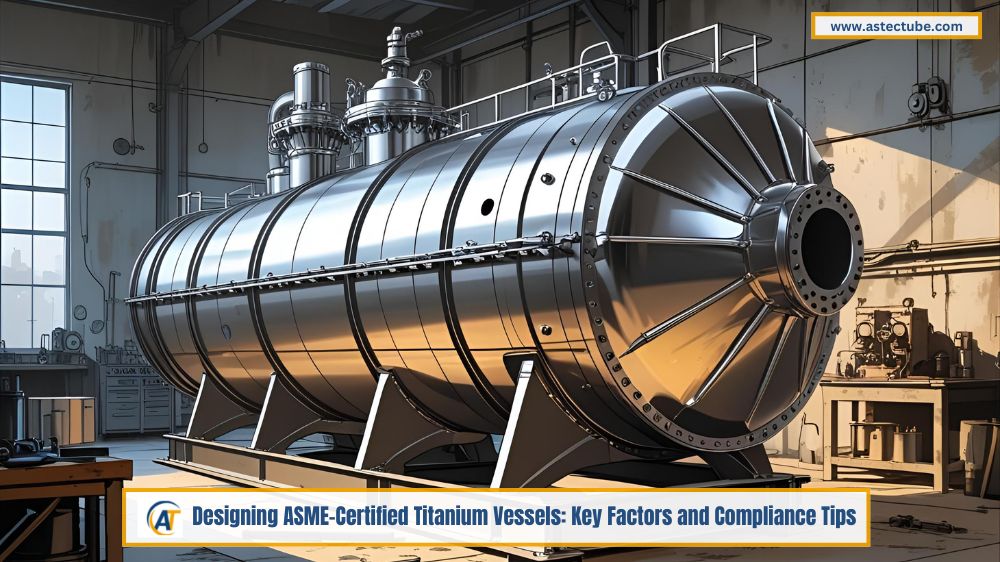Titanium vessels are increasingly used in industries that demand exceptional corrosion resistance, high pressure endurance, and minimal maintenance. These vessels are particularly valuable in sectors such as chemical processing, petrochemicals, pharmaceuticals, and marine environments. However, when a titanium vessel is intended to operate under pressure, ASME certification becomes essential to ensure its design, material selection, and fabrication methods meet stringent safety and reliability standards.
This article provides a comprehensive overview of the important design considerations and ASME compliance requirements for manufacturing ASME-certified titanium vessels.
Understanding ASME Certification for Titanium Vessels
The American Society of Mechanical Engineers (ASME) Boiler and Pressure Vessel Code (BPVC) is globally recognized for pressure vessel design and construction. An ASME-certified titanium vessel meets the technical, mechanical, and quality assurance criteria required under the ASME Section VIII Division 1 or 2 codes.
ASME certification is not just a regulatory requirement — it is a globally accepted benchmark of safety, precision, and durability. Certification involves approval by an Authorized Inspector (AI), rigorous documentation, testing, and strict material and welding controls.
Key Design Considerations for Titanium Vessels
1. Material Selection and Titanium Grades
Selecting the appropriate titanium grade is critical to the vessel’s long-term performance and chemical compatibility. Common grades used in pressure vessels include:
-
Grade 2 Titanium: Commercially pure titanium with excellent corrosion resistance and formability. Suitable for most chemical and pharmaceutical applications.
-
Grade 5 (Ti-6Al-4V): Titanium alloy with higher strength and temperature resistance. Used in high-pressure or aerospace-grade equipment.
-
Grade 7 and Grade 12: Titanium alloys with enhanced corrosion resistance in reducing or oxidizing environments, often used in chlorinated media.
Material selection must comply with ASME Section II Part D for allowable stresses, chemical composition, and mechanical properties.
2. Wall Thickness and Internal Pressure Rating
Wall thickness is calculated based on internal pressure, material strength, design temperature, corrosion allowance, and code-defined safety factors. The design must conform to ASME Section VIII formulas.
-
Thin-wall design is suitable for moderate pressures and helps in weight reduction.
-
Thick-wall vessels are required for high-pressure or vacuum service and must consider fatigue loading, especially in cyclic operations.
The minimum wall thickness also depends on the manufacturing process, such as rolling, welding, and post-fabrication treatments.
3. Corrosion Allowance and Operating Environment
Even though titanium has outstanding corrosion resistance, a corrosion allowance is often included in the design based on the operating media. However, in highly aggressive chemical applications, it is recommended to use corrosion testing data or perform life-cycle assessments before finalizing the thickness.
Designers must evaluate:
-
pH range
-
Chloride concentration
-
Temperature
-
Presence of oxidizing or reducing agents
4. Welding Procedures and Qualification
Welding titanium requires highly controlled conditions due to its reactivity with oxygen, nitrogen, and hydrogen at elevated temperatures. ASME mandates strict adherence to welding standards.
-
Welding procedures must be qualified per ASME Section IX
-
Welders and welding operators must be certified for titanium welding
-
Welding must be done in argon-shielded environments with purge chambers or glove boxes
-
Post-weld cleaning and inspection are essential to remove surface contaminants
Common welding processes include GTAW (TIG welding) for high precision and plasma arc welding for thicker sections.
5. Heat Treatment and Stress Relieving
Titanium generally does not require post-weld heat treatment unless specified for certain grades or service conditions. However, for thick-walled or high-strength vessels, annealing or stress-relieving may be required to enhance mechanical stability and reduce residual stresses.
ASME BPVC does not mandate specific heat treatments unless the design or service condition justifies it. The decision is based on fatigue analysis, cyclic pressure loads, and inspection findings.
6. Non-Destructive Testing (NDT) and Inspection
ASME-certified vessels must undergo NDT as per ASME Section V. The testing method depends on the application and code requirements.
-
Radiographic Testing (RT): For full or partial weld inspection
-
Dye Penetrant Testing (PT): For surface flaw detection
-
Ultrasonic Testing (UT): For thickness measurement and flaw detection in base materials
-
Visual Inspection (VT): Performed at multiple fabrication stages
In addition to these, hydrostatic or pneumatic pressure tests are required to validate the integrity of the pressure boundary.
7. Documentation and ASME Compliance Process
A complete ASME certification process for titanium vessels involves:
-
Design calculations per ASME Section VIII Div. 1 or 2
-
Certified Material Test Reports (CMTR) for all titanium used
-
Welding Procedure Specifications (WPS), Procedure Qualification Records (PQR), and Welder Performance Qualifications (WPQ)
-
Inspection Test Plans (ITPs) and Quality Assurance Plans (QAPs)
-
Final inspection reports and stamping by an Authorized Inspector (AI)
-
Issuance of U-Stamp or UM-Stamp after compliance
The manufacturer must hold a valid ASME certification and be regularly audited for quality and code compliance.
Common Industrial Applications of Titanium Vessels
ASME-certified titanium vessels are used in several high-risk, high-value applications including:
-
Chlor-alkali plants
-
Acid production units
-
Pharmaceutical API reactors
-
Offshore oil platforms and marine desalination
-
Heat exchangers and condensers
-
Food-grade or hygienic process vessels
Due to their low life-cycle cost and resistance to aggressive media, titanium vessels outperform traditional stainless steel or lined carbon steel options in demanding environments.
Conclusion
Designing ASME-certified titanium vessels requires in-depth knowledge of material behavior, pressure boundary engineering, welding control, and global safety standards. The success of these vessels in demanding applications depends on precise engineering, qualified workmanship, and strict adherence to ASME BPVC requirements.
Whether you are a chemical plant operator, project engineer, or procurement specialist, selecting the right titanium vessel design and partnering with an ASME-certified manufacturer is critical for operational reliability and safety.

